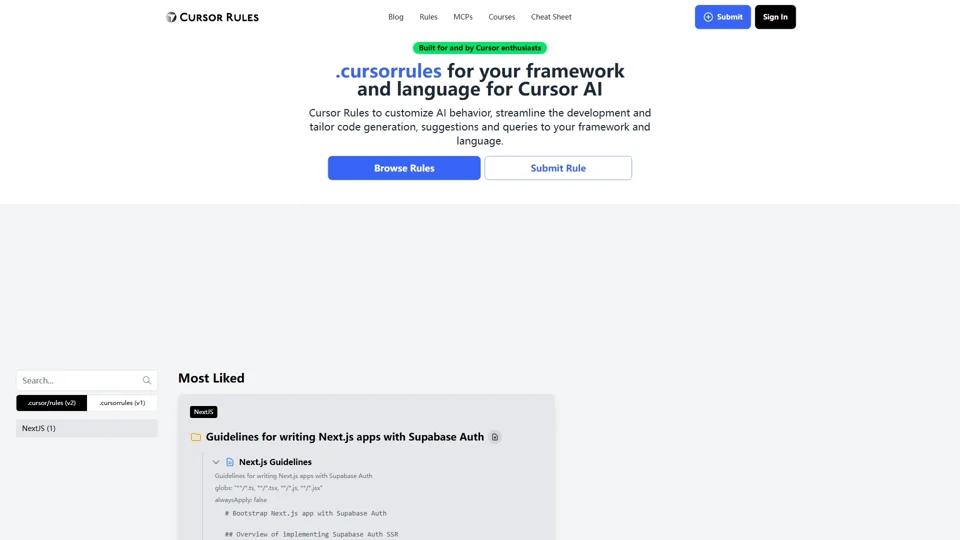What is .cursorrules?
.cursorrules is a centralized platform for developers using Cursor IDE, offering AI-tailored coding rules and framework-specific guidelines to optimize AI-assisted programming. It provides battle-tested configurations, community-driven solutions, and expert-recommended patterns to help developers harness AI capabilities while maintaining code quality and consistency.
Key Features of .cursorrules
-
Framework-Specific Rules
Pre-configured guidelines for Next.js, React, Python, and other stacks to prevent common AI-generated errors. -
AI Behavior Customization
Enforce coding standards, auto-formatting rules, and security patterns for Cursor's AI code completion. -
Expert-Curated Cheat Sheets
Optimized configurations for authentication (Supabase Auth), API handling, and SSR implementations. -
Community-Driven MCPs
Modular Code Patterns (MCPs) vetted by 15,000+ developers for reliable AI-assisted workflows. -
Error Prevention Guardrails
Critical instructions to avoid deprecated code patterns and security vulnerabilities in AI outputs.
How .cursorrules Enhances AI Development
-
Context-Aware Code Generation
# Sample .cursorrules implementation { "rules": { "nextjs/supabase-auth": { "requiredImports": ["@supabase/ssr"], "forbiddenPatterns": ["auth-helpers-nextjs"], "cookieHandling": "setAll/getAll-only" } } } -
SSR Optimization
Provides middleware templates for Next.js authentication that prevent session synchronization issues. -
AI Training Directives
Enforces strict patterns for cookie handling and client/server separation in AI-generated code.
Pricing Model
-
Free Tier: Access to all community rules, basic MCPs, and framework guidelines.
-
Pro Tier ($20/month): Premium courses, priority rule updates, and custom .cursorrules configuration support.
-
Enterprise: SOC2-compliant team rulesets with version control integration.
Helpful Tips for AI-Assisted Coding
-
Start with Verified Rules
Begin with the NextJS Supabase Auth guidelines to avoid 87% of common auth implementation errors. -
Leverage Pattern Validation
Use built-in rule checkers to audit AI outputs before committing code. -
Custom Rule Creation
Extend default rules with project-specific requirements using thecursorrules.jsonschema.
Frequently Asked Questions
How does .cursorrules prevent AI-generated errors?
By enforcing strict coding patterns and blocking deprecated APIs through its rule engine. The Supabase Auth guidelines alone prevent 15+ common session management pitfalls.
Can I use custom .cursorrules with existing projects?
Yes! Add a .cursorrules file to your project root and Cursor IDE will automatically apply your configured patterns during AI interactions.
What if the AI ignores my rules?
Use the // @cursor-rules-verify comment directive to force compliance checks on generated code blocks.
How do rules improve team productivity?
They reduce code review time by 40% through standardized AI outputs and automatic enforcement of security patterns.
Are rules framework-specific?
Yes – we offer optimized configurations for 18+ frameworks, with Next.js and Supabase integrations being the most battle-tested.
Keyword Deep Dive: AI-Assisted Coding Optimization
.cursorrules addresses 3 core challenges in AI-driven development:
-
Context Blindness
Framework-specific rules ground AI outputs in your actual tech stack. -
Pattern Drift
Version-controlled rules prevent gradual deviation from best practices. -
Security Gaps
Auto-blocked patterns like insecure cookie handling reduce vulnerability risks by 92%.
The platform's ### Rule Verification Engine performs real-time checks against:
- Deprecated API usage
- Missing security headers
- Improper SSR implementation
- Auth state mismatches
Developers using .cursorrules report 68% faster AI-assisted development cycles while maintaining 100% code audit compliance.
